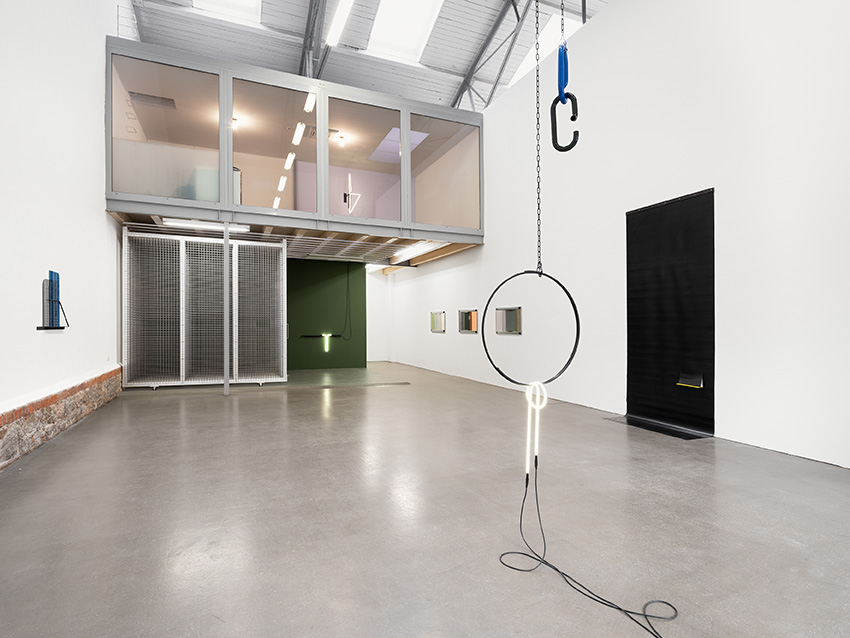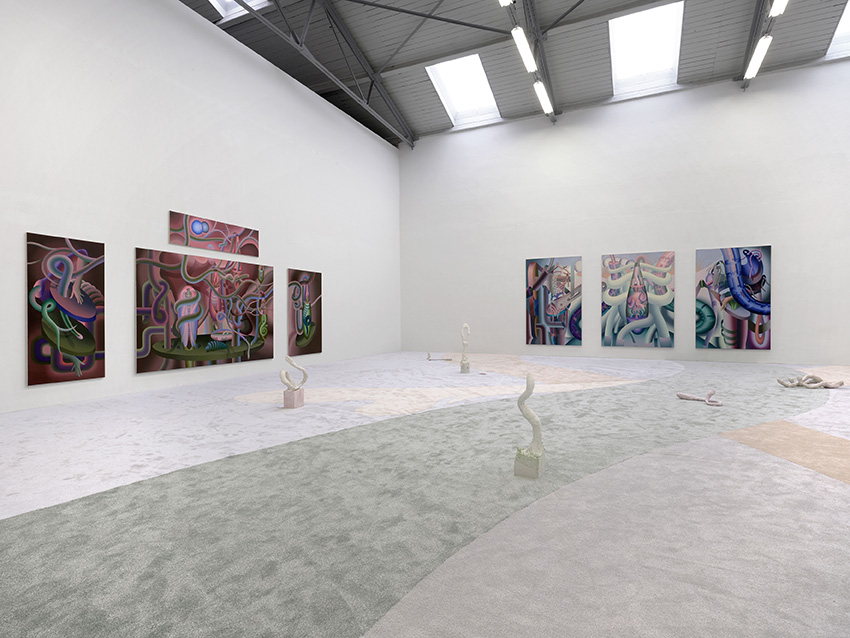Stef Heidhues I Igor Hosnedl
March 11 - April 15, 2023
Galerie EIGEN + ART Leipzig
In Stef Heidhues' current exhibition, it is noticeable that the presentation of her new works seems to follow a different approach than is usually the case. Unlike a "spatial image", the visitors are confronted with a kind of well thought-out display of works. Individually conceived works are positioned next to those that are designed serially and that also implement this seriality in the spatial structure.
Heidhues' works often contain form quotations from everyday life and borrowed from functional objects. They emerge from playful-poetic associations and from a material-related and experimental process. Stef Heidhues sometimes incorporates industrial elements, whose empty, "innocent" surfaces she explores with allusions, experimenting with aesthetic possibilities.
For example the panel series (2022) consists of wall objects and is developed from shelves from heavy-duty racks. Formal elements made of coloured Acrystall, glass and steel flow into modular systems based on a mixture of formal rigour and calculated chance.
Moreover, the visitor is presented with concise monochrome surfaces whose titles mud, orange fluo or light yellow allude to eyeshadow palettes. This is accompanied by neon lights and glass panes layered on top of each other - and finally a large-scale, black rubber mat, which, under the suggestive title Slot Machine, recalls a kind of architectural or object representation in its constructivist appearance by means of line and surface and then transfers itself from the surface into the space.
All of this centres around a pointedly placed light work in the middle of the room, which seems to have descended from the ceiling in an almost dancerly manner on a pair of rings. In view of the dialogue between the works that unfolds successively as one walks through the exhibition, the feeling creeps in that the idea of a mere display of works if not what we are experiencing after all. And when we leave the room, it is as if we are stepping out of a coherent spatial image.

––––––––––
In Igor Hosnedl’s dusty field of equivalence, where parts are shattered, flora and fauna merge, time is confused and depth is undermined, it’s just surface, everywhere. Alternating between a surfeit and deficit of body parts, gestures and markers of the human, the completion of a figure is promised but withheld. This universe is an insistently fractured one, revealing asymmetries to equalise, diplopic images to reconcile, and cognitive and physical dissonances to resolve. Though unsettling, this sense of being both inside and outside a narrating self, produces a general, and familiar, atmosphere of ambivalence and opacity. It is ambiguous as to whether the phantasmal creatures – often headless and organless – that populate Hosnedl’s crepuscular, pulverous paintings are living or dead, or either. Are they undergoing formation or are they already disintegrating? If the artist’s images are oneiric they are, more specifically, the ones drafted between dreams, that brief interval where delirium reloads itself. Together, the works form something of a fragmentary, paranoid dreamwork, with certain symbols and threats appearing over and over and never finding resolution: the claustrophobic chamber; the risk, and the event, of castration; the hand that cannot grab the knife in time; the pouch that must be guarded at all costs; the masked golem whose identity is recognised nonetheless.
Hosnedl dips his brush into pyres of coloured powder, sweeping the particles onto swathes of glue, his painted scenes play out in aseptic chambers that could be a workshop or repair shop; they might also be morgues or operation theatres. In their exclusion of outside stimuli they afford total attention to the task at hand. Everywhere tender nerve endings: frayed fibres, tangled cables, coiled tendrils, split ends, thirsty roots. Everywhere amputation and dismemberment. It should be said that the cut is always clean. This is a bloodless realm. The stuff of flesh is less animal, more vegetal – the cut endings reveal concentric circles, like the rings of a tree, or the xylem and phloem of a carrot.
The amputated limb-tendril hybrids in Hosnedl’s still lifes are often set in small glasses of water atop a desktop for safekeeping: the promise of a future propagation. New specimens will be bred from the injured parent stock, which is already showing signs of regeneration.
The unrelenting drive of life beats on.
The glue, upon which Hosnedl disperses and crafts his ground up forms, dormant bodies and compressions of time, becomes the site not for repair but for adhesion. It becomes the petri dish in which the coalescence of Others, a sublime intermingling and fantastic cyborg building can take place. What do we want to do with it?
